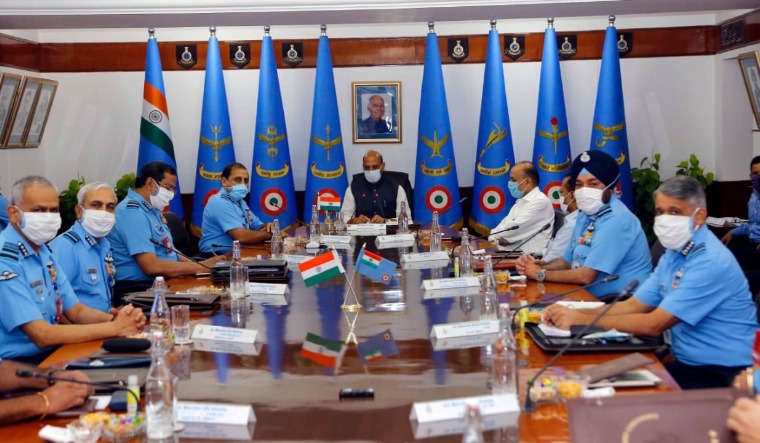Alluding to the ongoing de-escalation efforts on the Line of Actual Control with China, Defence Minister Rajnath Singh has urged the Indian Air Force to "stand ready to handle any eventuality". Rajnath Singh, during his visit last week to Lukung close to Pangong Tso, had already hinted the matter (de-escalation) should be resolved through talks but there was no guarantee of what happens in future.
Addressing the Indian Air Force's Commanders Conference at Air Headquarters in the national capital on Wednesday, Rajnath stated that the professional manner in which IAF conducted the air strike in Balakot last year as well as the rapid deployment of its assets at forward locations in response to the prevailing situation in eastern Ladakh has sent a "strong message to the adversaries".
"The nation’s resolve to defend its sovereignty stands firm on the faith its people have in the capability of its armed forces," Rajnath Singh said. For last two months, IAF's combat fleet is regularly carrying out combat air patrols on the border areas in eastern Ladakh.
In the Ladakh sector, the IAF has already deployed its key air assets like Sukhoi-30MKI, MiG-29, newly inducted Apache attack helicopters and Chinook heavy-lift multi-mission helicopters. And top commanders of the Indian Air Force are considering an option to deploy five Rafale fighter jets, which are going to land in India on July 29, in the Ladakh sector as well. The Indian Air Force intends to make these Rafale jets operational at the earliest and first squadron of the jets will be based at Ambala. Moreover, Indian Navy's MiG-29K fighter jets are also adding teeth to Indian Air Force’s combat capability in northern sector. The Indian Navy operates nearly 45 MiG-29Ks and only 18 are deployed on the aircraft carrier INS Vikramaditya.
Speaking at the conference, Chief of Air Staff Air Chief Marshal R.K.S. Bhaduria made it clear that the Indian Air Force was well prepared to counter "short term" as well as "strategic threats" and the units were evenly poised to counter any aggressive action by the adversary. "Response by all commands in ensuring deployment and readiness of forces was prompt and laudable," the Air Force chief said while emphasising the need to focus on the capability to handle situations at a short notice for ensuring a robust response.
While praising Indian Air Force’s contribution in fighting the COVID-19 pandemic and the role played during several humanitarian missions, Rajnath also highlighted the need to achieve self-reliance in defence production and noted that the theme chosen for this AFCC—‘IAF in the Next Decade’—was very apt for enhancing efforts towards indigenisation in the days to come. Rajnath lauded the progress made towards enhancing synergy and integration within the three services since the appointment of a CDS and creation of department of military affairs (DMA). The defence minister concluded by acknowledging IAF’s role in adapting to changes in technology and adopting emerging capabilities in nanotechnology, artificial intelligence, cyber and space domains. He assured the commanders that all requirements of the armed forces, whether financial or otherwise, would be fulfilled.
During the three-day conference, commanders will review the current operational scenario and deployments before deliberating on building the Indian Air Force’s capabilities in the next decade to tackle all emerging threats.



